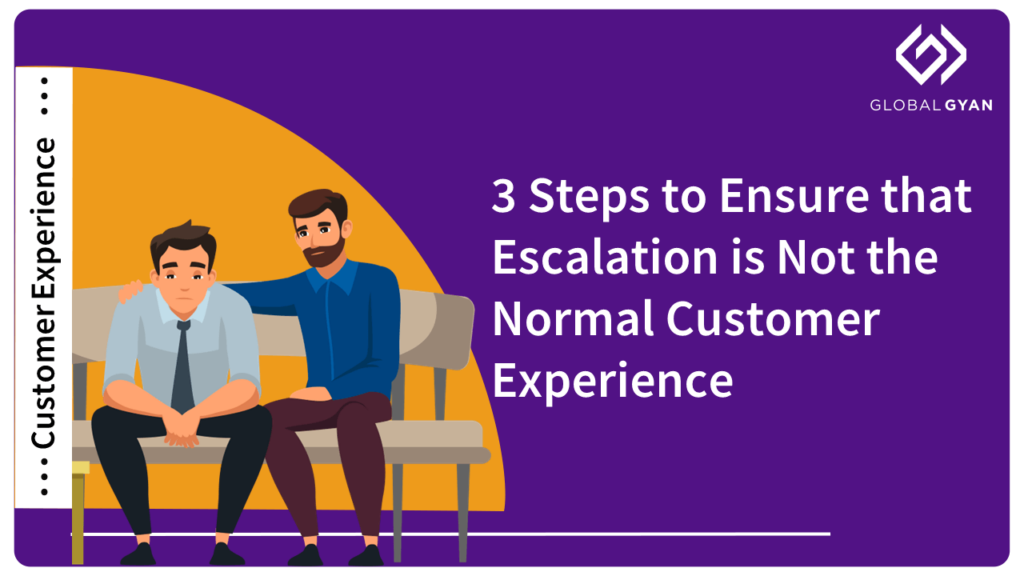3 Key Steps to Avoid Escalation in Customer Experience

Years ago, I used to work with Tata Communications, Shachin Bharadwaj, founder of TastyKhana in Pune, sent me this Twitter message about his escalation issue:

This was in response to:

Just days later, I faced an almost similar situation. I was trying to buy some products urgently for my home and reached out to the relevant sales guys in Pune. For almost a week there was no response, in spite of several calls and messages. Finally, I called a friend who is a senior manager in that company. Although he was not responsible for this line of products, I called him on a Sunday morning, having run out of ideas. Within an hour, the sales guy called me asking for the details.
I used to receive several “escalations” from customers and friends, even though I was not in a “line” role… Those who are in business sales / marketing or customer service leadership roles are inundated with escalations.
Why does this happen? Why is it that large organizations are often unable to handle sales or customer service issues at the operating level?
Clearly, “escalations” are not good for them, not only from a reputation perspective but also from a cost point of view. On the other hand, corporates would argue that such escalations are few, relative to the overall number of transactions. If you have a 100 million subscribers with 10 “transactions” each, even a 99.9% quality level would result in a million “failed” transactions. It is impossible even for the best businesses to achieve 100% in their operations.
But, as Usha explains in this article, for the customer, her experience is the only thing that matters, not your six sigma performance.
It worked earlier, right?
Earlier, businesses used to get away with it. An individual (customer) had limited ability to influence others or have her voice heard. An aggrieved customer could write to the company’s senior management or to a publication and hope that something would come out of it. Perhaps some would go to a consumer court.
Things are different now. One aggrieved customer (even if accounting for the fourth decimal of all transactions) can ruin a company’s carefully crafted image.

The only way to get it always right is if every member of the organization focuses on solving customer issues or preventing the creation of any issues. How often does that happen?
I want to share 3 changes that will ensure issues are addressed at the operating / first level, leading to greater customer satisfaction and reduced escalation.
#1. Match Metrics and Incentives to Goals
What are the most popular metrics for customer service organizations? Call centre staff are usually measured on number of calls, hold time, etc. A telecom service engineer is measured on network uptime, capacity utilization, etc. Very rarely are they tasked to enable happy customers. Customer satisfaction indices become part of larger corporate imperatives and company performance scores. I have not seen too many companies that directly measure (and consequently, incentivize) customer experience – satisfaction that is tracked at an individual transaction level and not at the aggregate in an annual or quarterly survey.
Similarly, a sales person is tasked to maximize new sales or revenues; most companies have complex commission structures that encourage sales of certain products (or to certain segments) over others. A sales person inevitably follows the money. If you are not a “priority” customer segment or seeking a low-value product, the sales guy has no interest in you, period.
Ensure there is a match between what you want to achieve and what you want to measure.
#2. Empower the Real Decision Makers
What are you willing to do to solve a customer issue? Ask any senior manager and you will always hear the answer, “Anything, customer is king.” Unfortunately, that message rarely reaches the line staff — not from a communication perspective, mind you, but in terms of policies and delegations. Does the organization recognize and celebrate moments when difficult customer issues were resolved speedily? Were employees who went out of their way to solve the problem rewarded immediately? Or was the first reaction of the management to conduct a cost-benefit analysis of the event?
Empowerment is also in terms of information. Customers are, mostly, not irrational. They understand that things/systems/machines do fail. What they’d like to know is why, and more importantly, how/when will the issue be resolved. I have never seen a customer service executive that has been empowered with such information. In the absence of facts, the CSE responds with vague promises and a generic assurance of resolving the issue within 24 hours or 48.
A few years ago, my broadband connection was down and every time I called, I was told the issue would be resolved “soon”. A week later, the connection was still down and my blood pressure was up. After a few rounds of escalation, I learnt that some equipment had been damaged and regulatory approvals could take a few more days; nothing about it. If only I had been informed earlier, I would have managed it differently, without any escalation.
Ensure your front-line staff are empowered with information and decision-making capabilities, and back them up, always!
#3. Learn from Errors
Each escalation is a moment of learning. Why did it not get addressed at the level it should have been? What was lacking? Senior executives that receive escalations focus on the immediate solution (as they must) but often fail to deep dive into the real problem. Whether it is a change in incentives or a process, or a reprimand in case of negligence, something must change after each deviation from the norm of operations.
It is also important that even after an escalation, the operating teams must address the issue. That sends a message to the operating staff as well as to the customer: the escalation was an exception. The customer point of contact for the issues does not change. Escalation should not become a habit.
Of the three, I believe that wrong measurement/incentives is the most serious. This is further compounded by complex organization structures and their siloed incentive systems. If you want to eliminate escalation, make every employee feel that they are responsible for customer satisfaction. Do you know of Indian companies that practice such a mantra?
A version of this article first appeared at my earlier blog







